
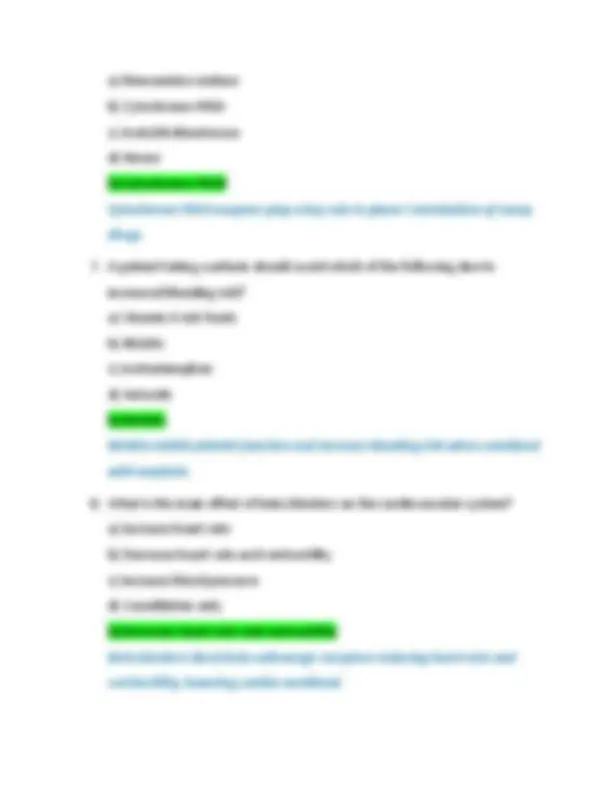
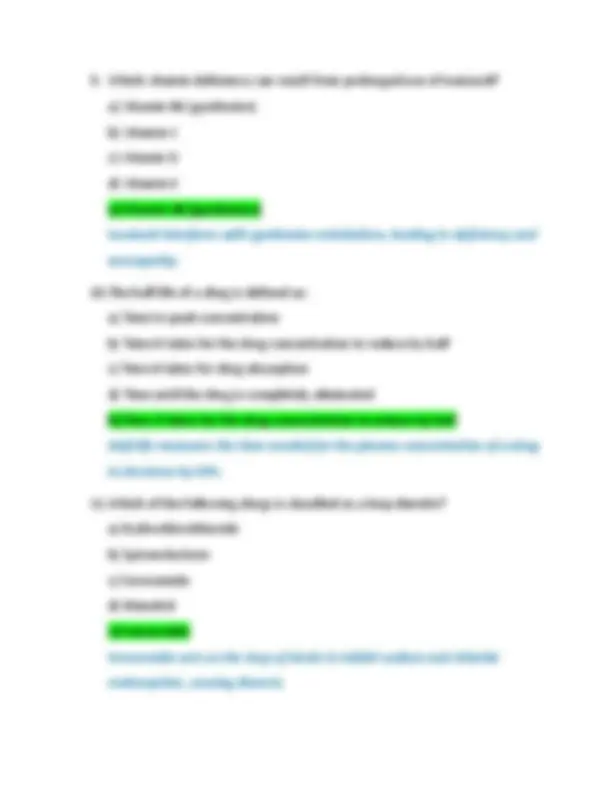
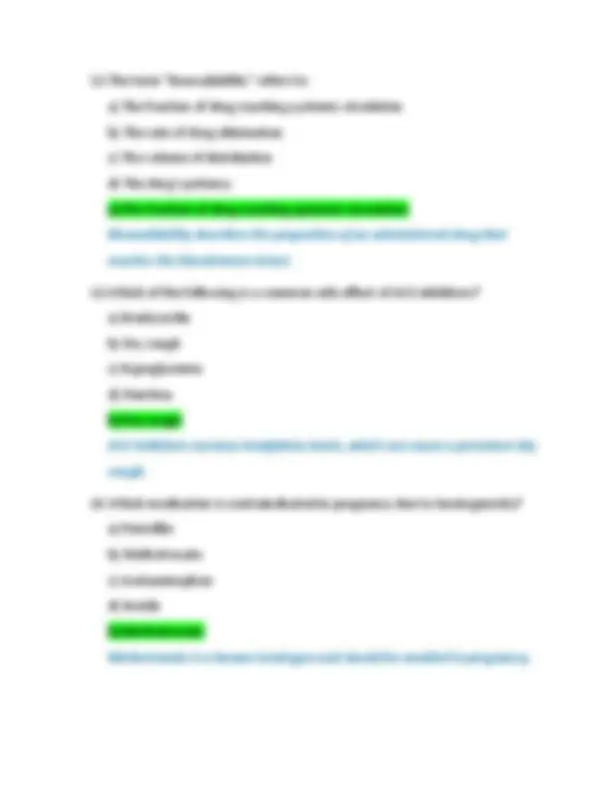
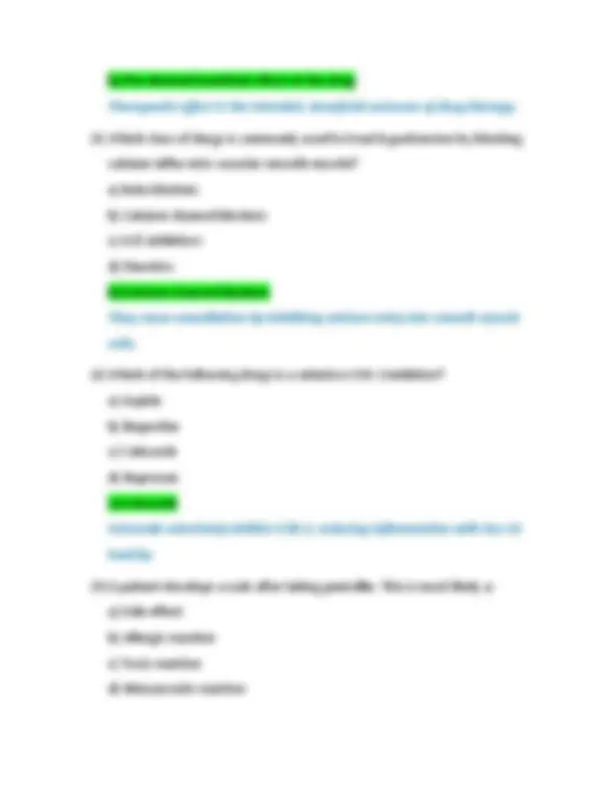
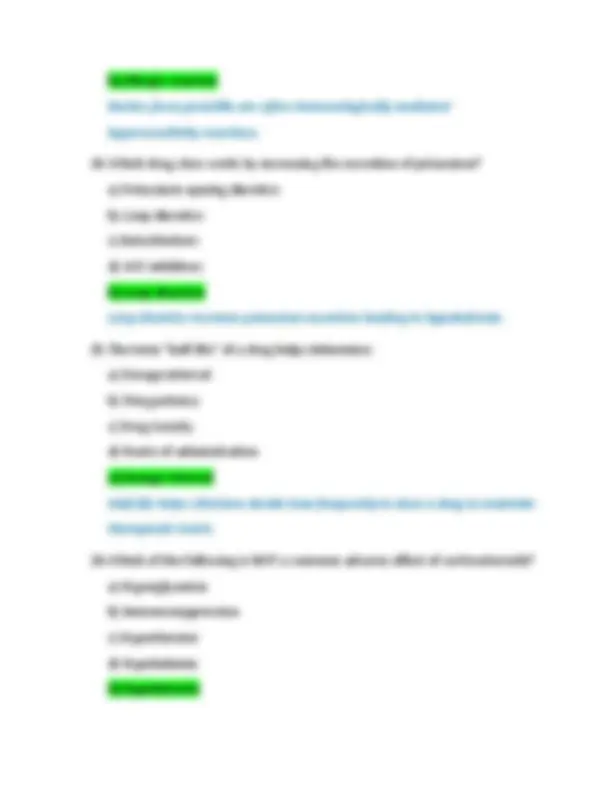
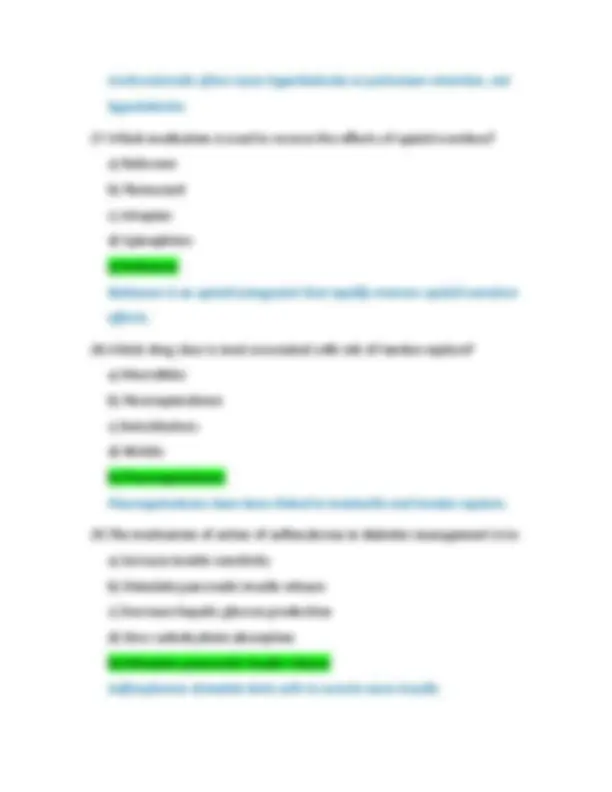
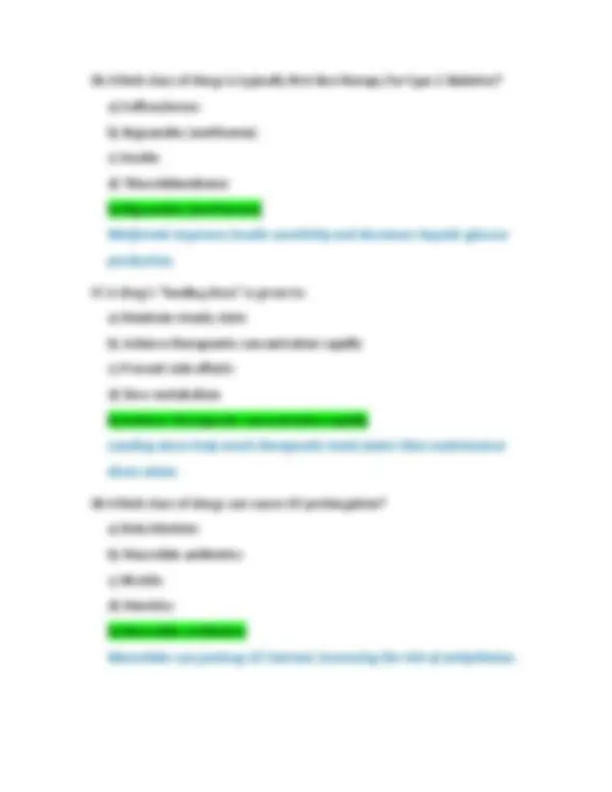
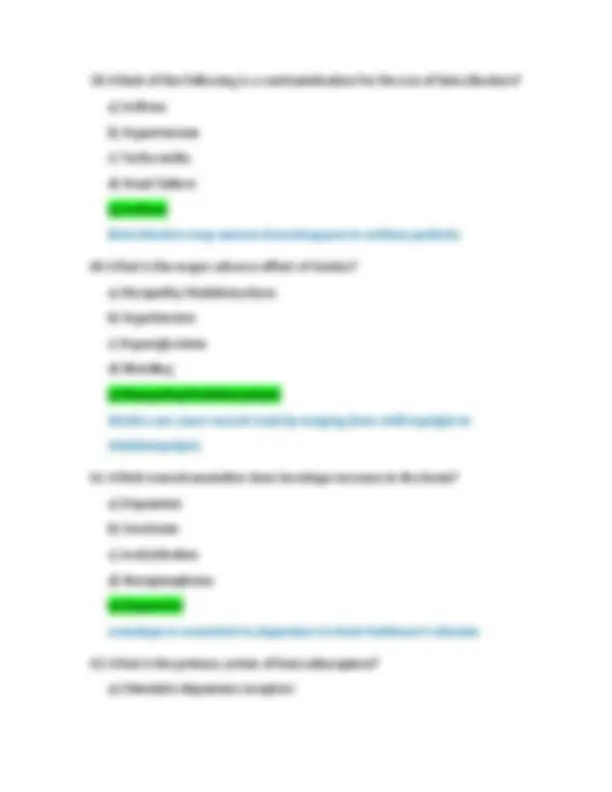
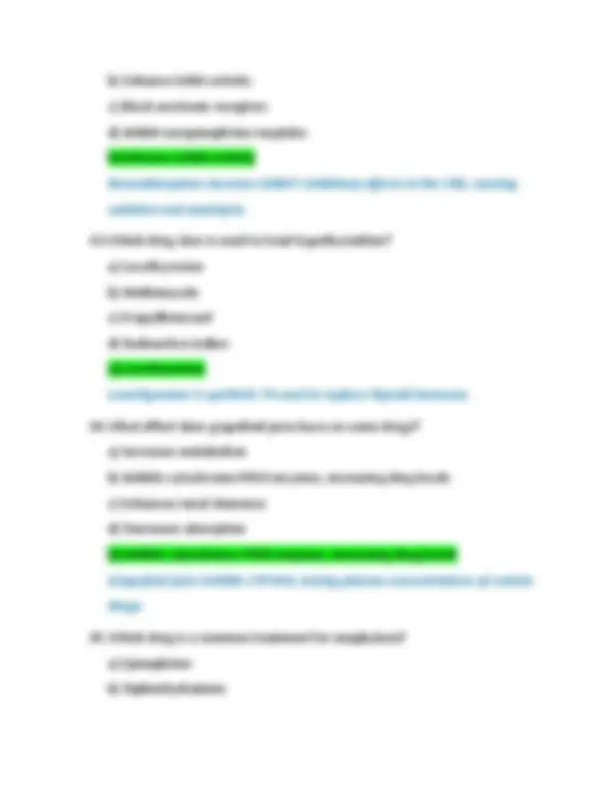
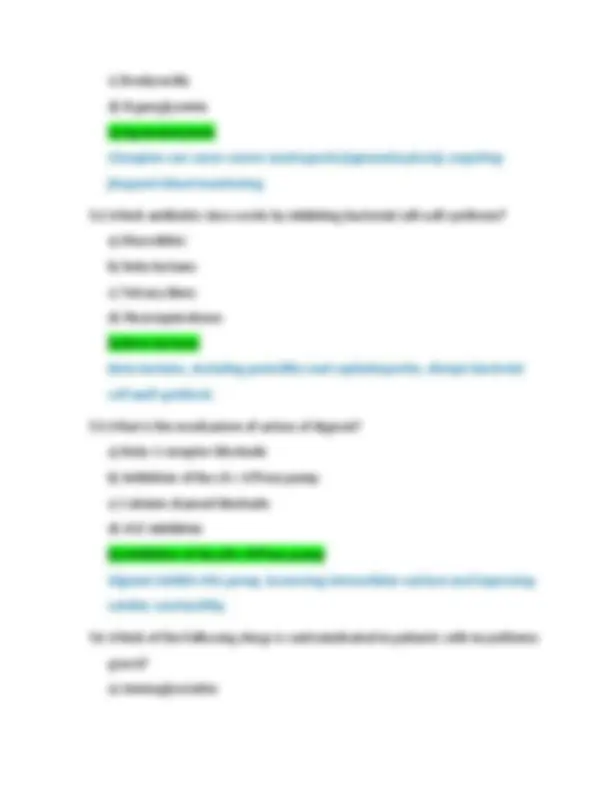
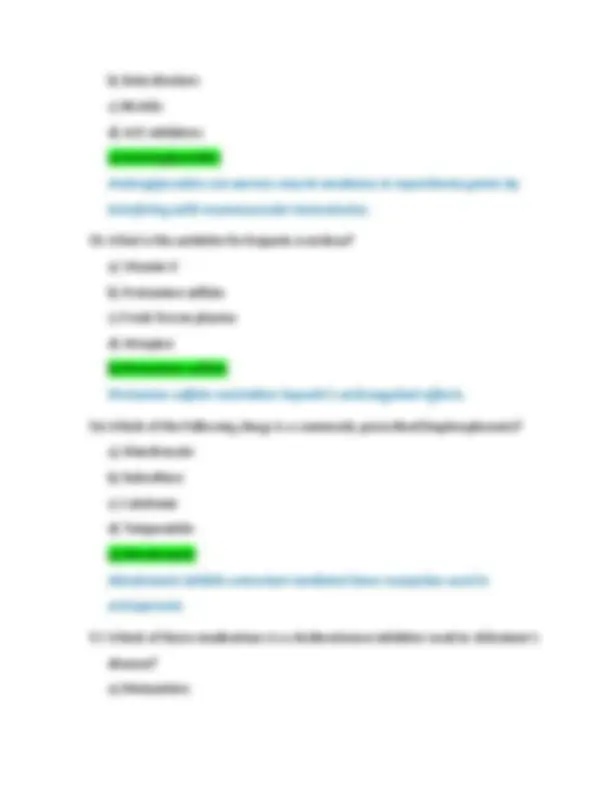
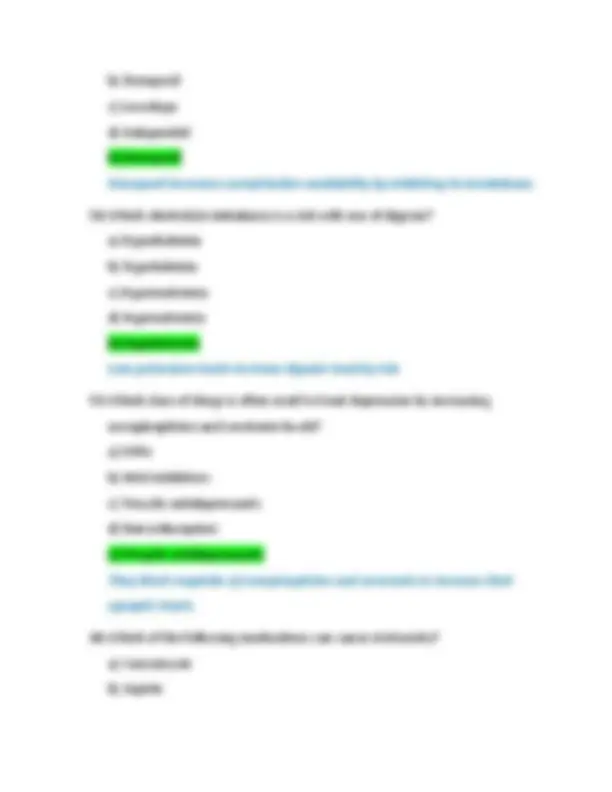
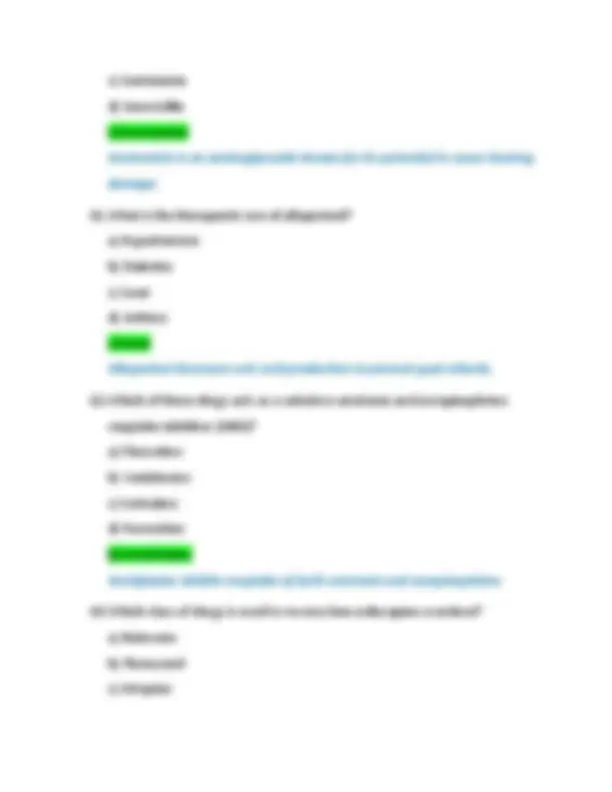
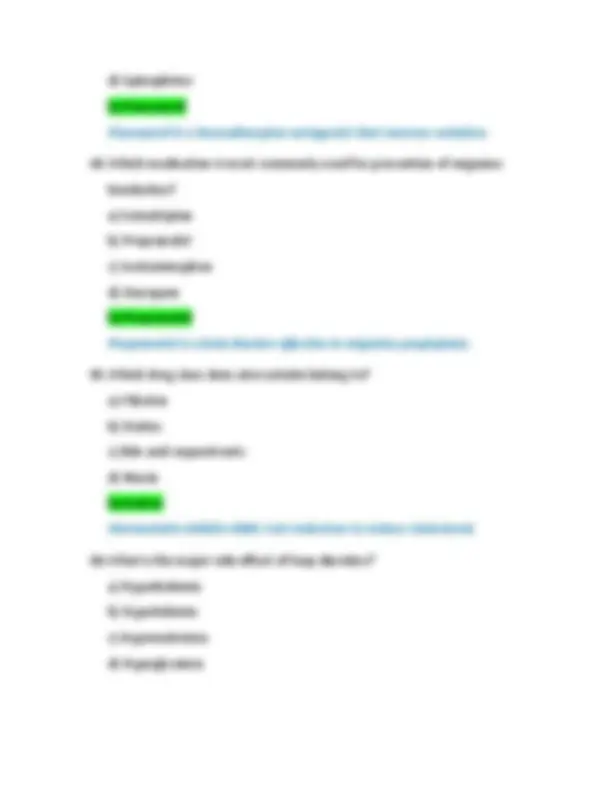
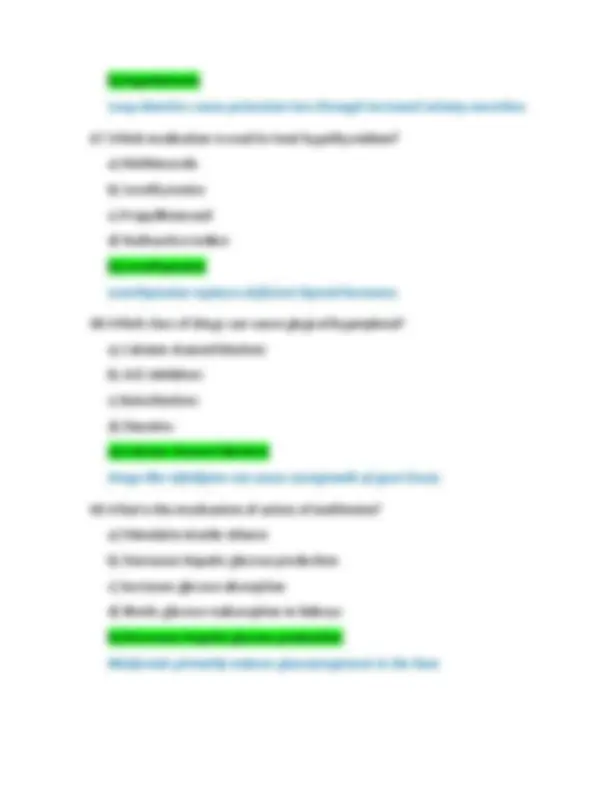
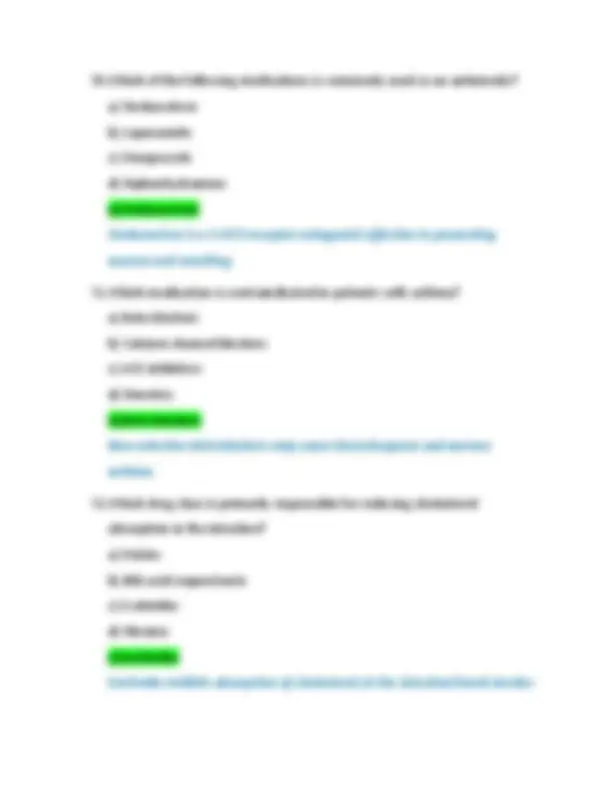
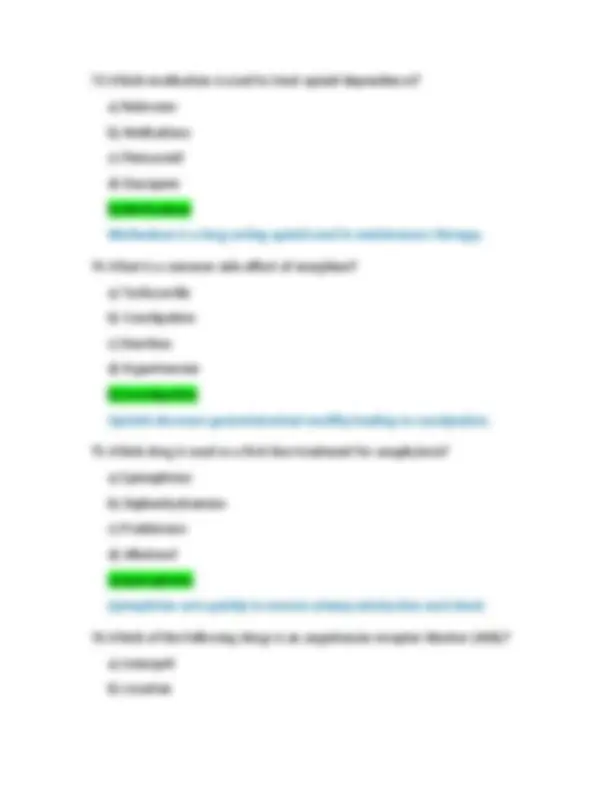
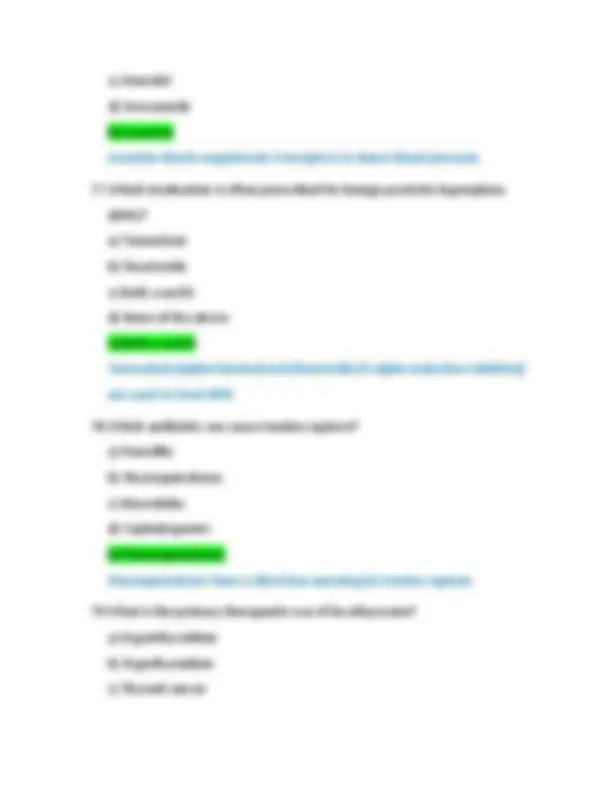
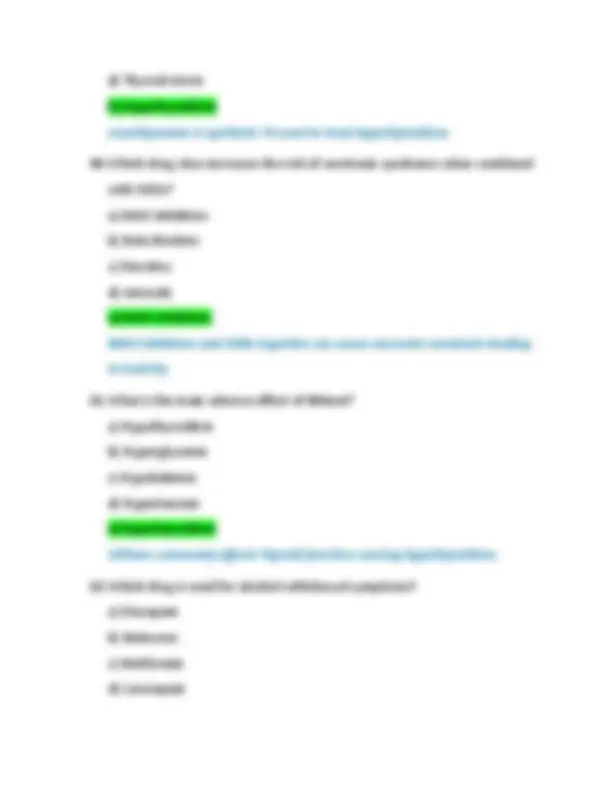
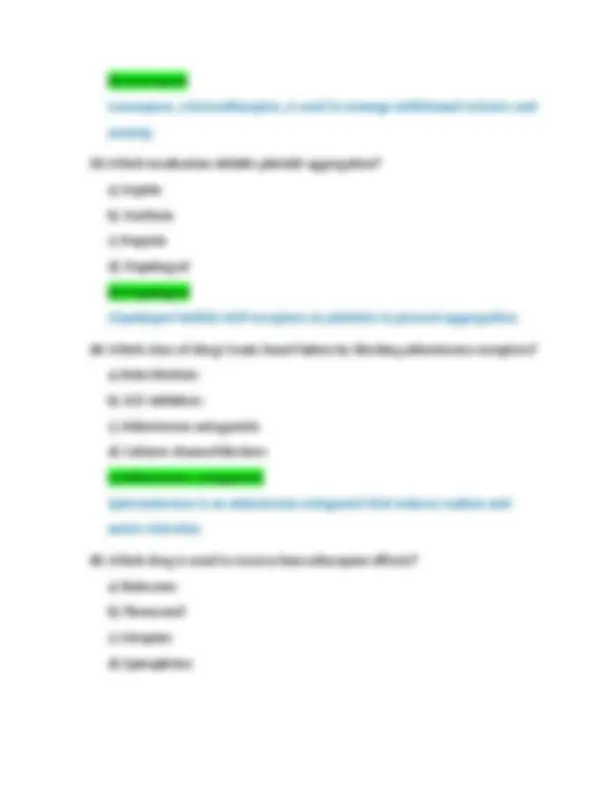
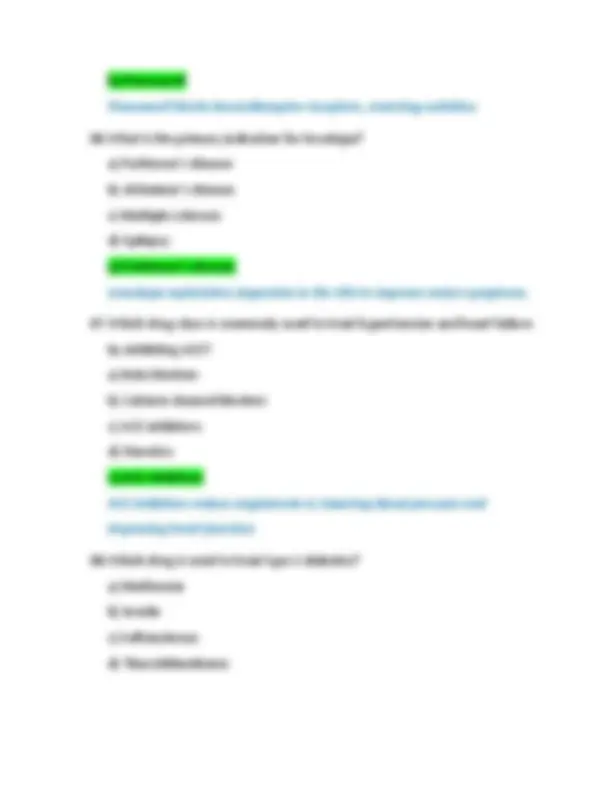
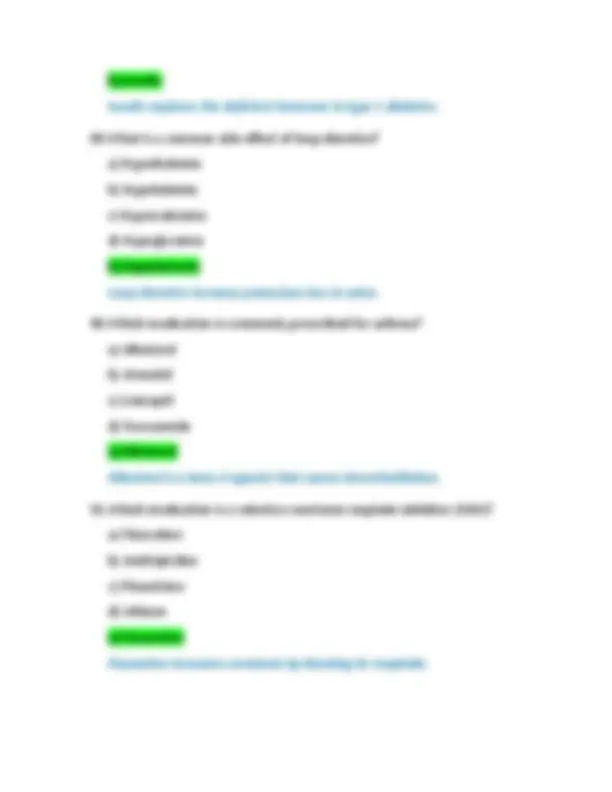
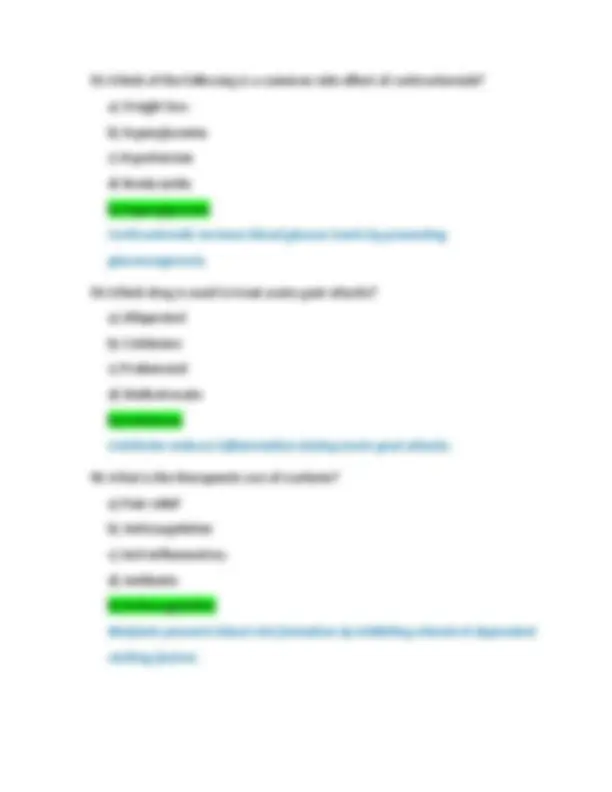
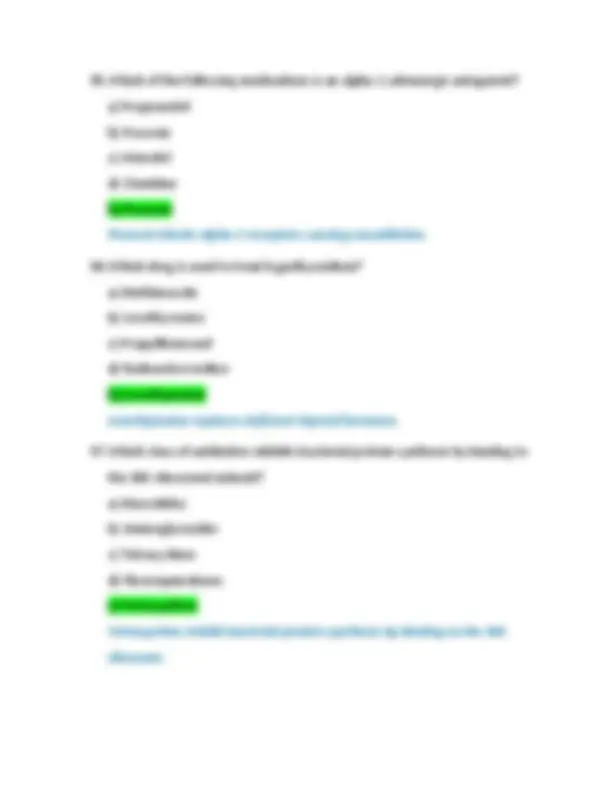
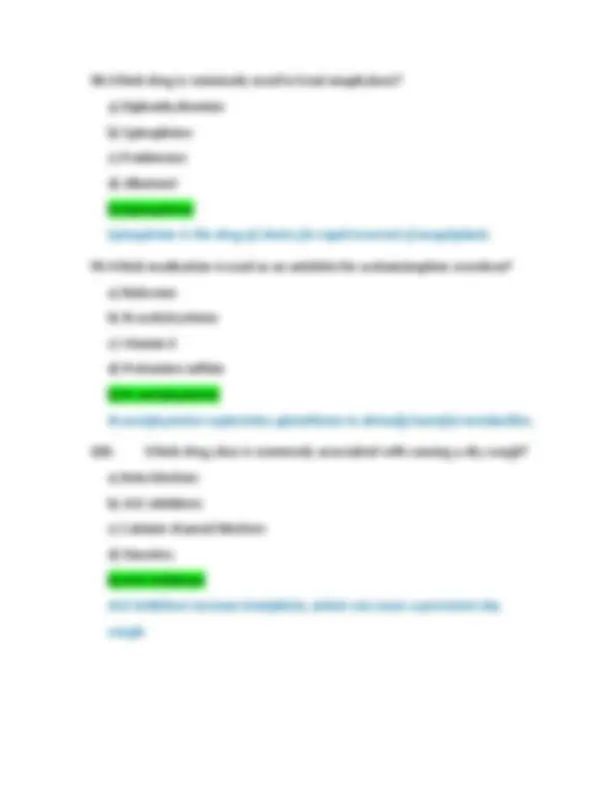


Study with the several resources on Docsity

Earn points by helping other students or get them with a premium plan


Prepare for your exams
Study with the several resources on Docsity

Earn points to download
Earn points by helping other students or get them with a premium plan
Community
Ask the community for help and clear up your study doubts
Discover the best universities in your country according to Docsity users
Free resources
Download our free guides on studying techniques, anxiety management strategies, and thesis advice from Docsity tutors
NURS 5334 Pharm Study Guide Quiz 1 (University of Texas - Arlington, 2024/2025).
Typology: Exams
1 / 33

This page cannot be seen from the preview
Don't miss anything!


























c) No monitoring needed d) Dose adjustment only for renal impairment b) Close monitoring of blood levels Narrow therapeutic index drugs have a small margin between therapeutic and toxic doses, necessitating frequent monitoring.
12.The term “bioavailability” refers to: a) The fraction of drug reaching systemic circulation b) The rate of drug elimination c) The volume of distribution d) The drug’s potency a) The fraction of drug reaching systemic circulation Bioavailability describes the proportion of an administered drug that reaches the bloodstream intact. 13.Which of the following is a common side effect of ACE inhibitors? a) Bradycardia b) Dry cough c) Hypoglycemia d) Diarrhea b) Dry cough ACE inhibitors increase bradykinin levels, which can cause a persistent dry cough. 14.Which medication is contraindicated in pregnancy due to teratogenicity? a) Penicillin b) Methotrexate c) Acetaminophen d) Insulin b) Methotrexate Methotrexate is a known teratogen and should be avoided in pregnancy.
18.What does the term “first-pass effect” refer to? a) Rapid renal elimination of a drug b) Initial metabolism of oral drugs by the liver before reaching systemic circulation c) Drug binding to plasma proteins d) Drug distribution to tissues b) Initial metabolism of oral drugs by the liver before reaching systemic circulation First-pass metabolism significantly reduces the bioavailability of some oral drugs. 19.Which of the following medications is used as an antidote for acetaminophen overdose? a) Naloxone b) Flumazenil c) N-acetylcysteine d) Activated charcoal c) N-acetylcysteine N-acetylcysteine replenishes glutathione stores to detoxify acetaminophen metabolites. 20.The therapeutic effect of a drug is best described as: a) The adverse reactions caused by the drug b) The desired beneficial effect of the drug c) The dose that causes toxicity d) The rate of drug metabolism
b) The desired beneficial effect of the drug Therapeutic effect is the intended, beneficial outcome of drug therapy. 21.Which class of drugs is commonly used to treat hypertension by blocking calcium influx into vascular smooth muscle? a) Beta blockers b) Calcium channel blockers c) ACE inhibitors d) Diuretics b) Calcium channel blockers They cause vasodilation by inhibiting calcium entry into smooth muscle cells. 22.Which of the following drugs is a selective COX-2 inhibitor? a) Aspirin b) Ibuprofen c) Celecoxib d) Naproxen c) Celecoxib Celecoxib selectively inhibits COX-2, reducing inflammation with less GI toxicity. 23.A patient develops a rash after taking penicillin. This is most likely a: a) Side effect b) Allergic reaction c) Toxic reaction d) Idiosyncratic reaction
Corticosteroids often cause hyperkalemia or potassium retention, not hypokalemia. 27.Which medication is used to reverse the effects of opioid overdose? a) Naloxone b) Flumazenil c) Atropine d) Epinephrine a) Naloxone Naloxone is an opioid antagonist that rapidly reverses opioid overdose effects. 28.Which drug class is most associated with risk of tendon rupture? a) Macrolides b) Fluoroquinolones c) Beta blockers d) NSAIDs b) Fluoroquinolones Fluoroquinolones have been linked to tendonitis and tendon rupture. 29.The mechanism of action of sulfonylureas in diabetes management is to: a) Increase insulin sensitivity b) Stimulate pancreatic insulin release c) Decrease hepatic glucose production d) Slow carbohydrate absorption b) Stimulate pancreatic insulin release Sulfonylureas stimulate beta cells to secrete more insulin.
30.Which electrolyte imbalance is a major concern with thiazide diuretics? a) Hyperkalemia b) Hypokalemia c) Hypercalcemia d) Hypocalcemia b) Hypokalemia Thiazides increase potassium excretion leading to hypokalemia. 31.The primary therapeutic use of digoxin is: a) Hypertension b) Atrial fibrillation and heart failure c) Diabetes mellitus d) Asthma b) Atrial fibrillation and heart failure Digoxin increases cardiac contractility and controls ventricular rate in atrial fibrillation. 32.Which drug requires monitoring of the international normalized ratio (INR)? a) Heparin b) Warfarin c) Clopidogrel d) Aspirin b) Warfarin INR monitoring is essential to avoid bleeding or clotting complications with warfarin therapy.
36.Which class of drugs is typically first-line therapy for type 2 diabetes? a) Sulfonylureas b) Biguanides (metformin) c) Insulin d) Thiazolidinediones b) Biguanides (metformin) Metformin improves insulin sensitivity and decreases hepatic glucose production. 37.A drug’s “loading dose” is given to: a) Maintain steady state b) Achieve therapeutic concentration rapidly c) Prevent side effects d) Slow metabolism b) Achieve therapeutic concentration rapidly Loading doses help reach therapeutic levels faster than maintenance doses alone. 38.Which class of drugs can cause QT prolongation? a) Beta blockers b) Macrolide antibiotics c) NSAIDs d) Diuretics b) Macrolide antibiotics Macrolides can prolong QT interval, increasing the risk of arrhythmias.
39.Which of the following is a contraindication for the use of beta blockers? a) Asthma b) Hypertension c) Tachycardia d) Heart failure a) Asthma Beta blockers may worsen bronchospasm in asthma patients. 40.What is the major adverse effect of statins? a) Myopathy/rhabdomyolysis b) Hypotension c) Hyperglycemia d) Bleeding a) Myopathy/rhabdomyolysis Statins can cause muscle toxicity ranging from mild myalgia to rhabdomyolysis. 41.Which neurotransmitter does levodopa increase in the brain? a) Dopamine b) Serotonin c) Acetylcholine d) Norepinephrine a) Dopamine Levodopa is converted to dopamine to treat Parkinson’s disease. 42.What is the primary action of benzodiazepines? a) Stimulate dopamine receptors
c) Prednisone d) Albuterol a) Epinephrine Epinephrine is the first-line treatment for anaphylaxis due to its vasoconstrictive and bronchodilator effects. 46.Which of the following medications is a selective alpha-1 adrenergic blocker? a) Prazosin b) Propranolol c) Clonidine d) Labetalol a) Prazosin Prazosin selectively blocks alpha-1 receptors causing vasodilation. 47.Which of these drugs is commonly used to treat tuberculosis? a) Rifampin b) Amoxicillin c) Ciprofloxacin d) Azithromycin a) Rifampin Rifampin is a first-line anti-TB drug inhibiting bacterial RNA synthesis. 48.What is the major adverse effect of lithium therapy? a) Hyperkalemia b) Hypothyroidism and nephrotoxicity c) Hyperglycemia
d) Hepatotoxicity b) Hypothyroidism and nephrotoxicity Lithium can cause thyroid dysfunction and renal damage with long-term use. 49.Which medication is used as a rescue drug for status epilepticus? a) Phenytoin b) Lorazepam c) Valproic acid d) Carbamazepine b) Lorazepam Lorazepam is a benzodiazepine used for rapid seizure control in status epilepticus. 50.What is the primary effect of H2 receptor antagonists? a) Increase gastric acid secretion b) Decrease gastric acid secretion c) Neutralize stomach acid d) Increase gastric motility b) Decrease gastric acid secretion H2 receptor antagonists block histamine on parietal cells, reducing acid secretion. 51.What is the main adverse effect of the drug clozapine? a) Agranulocytosis b) Hypertension
b) Beta blockers c) NSAIDs d) ACE inhibitors a) Aminoglycosides Aminoglycosides can worsen muscle weakness in myasthenia gravis by interfering with neuromuscular transmission. 55.What is the antidote for heparin overdose? a) Vitamin K b) Protamine sulfate c) Fresh frozen plasma d) Atropine b) Protamine sulfate Protamine sulfate neutralizes heparin’s anticoagulant effects. 56.Which of the following drugs is a commonly prescribed bisphosphonate? a) Alendronate b) Raloxifene c) Calcitonin d) Teriparatide a) Alendronate Alendronate inhibits osteoclast-mediated bone resorption used in osteoporosis. 57.Which of these medications is a cholinesterase inhibitor used in Alzheimer’s disease? a) Memantine
b) Donepezil c) Levodopa d) Haloperidol b) Donepezil Donepezil increases acetylcholine availability by inhibiting its breakdown. 58.Which electrolyte imbalance is a risk with use of digoxin? a) Hyperkalemia b) Hypokalemia c) Hypernatremia d) Hyponatremia b) Hypokalemia Low potassium levels increase digoxin toxicity risk. 59.Which class of drugs is often used to treat depression by increasing norepinephrine and serotonin levels? a) SSRIs b) MAO inhibitors c) Tricyclic antidepressants d) Benzodiazepines c) Tricyclic antidepressants They block reuptake of norepinephrine and serotonin to increase their synaptic levels. 60.Which of the following medications can cause ototoxicity? a) Vancomycin b) Aspirin